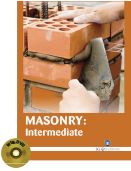Trade and Industrial Education

Masonry: Intermediate combines many different practical and visual skills with knowledge of specialized materials and techniques. Masonry is the building of structures from individual units laid in and bound together by mortar; the term masonry can also refer to the units themselves. The common materials of masonry construction are brick, building stone such as marble, granite, travertine, and limestone, cast stone, concrete block, glass block, and cob. This book will introduce the knowledge and skills for those studying and/or working in masonry.
About this Book
The information in this book covers basic to core competencies that a person must achieve that will enable him/her to perform construction of brick and concrete block structure, installation of pre-cast balluster/handrail and plastering of concrete wall surface.
About the Masonry Industry
Masonry workers, also known as masons, use bricks, concrete blocks, concrete, and natural and manmade stones to build walls, walkways, fences, and other masonry structures. The work is physically demanding because masons lift heavy materials and often must stand, kneel, and bend for long periods. Poor weather conditions may reduce work activity because masons usually work outdoors. Most masons work full time. A wide variety of careers are available within the masonry industry from mason to instructor to project manager. Depending upon your interests, you could pursue opportunities in many different areas of masonry. Employment of masonry workers is projected to grow 15 percent from 2014 to 2024, much faster than the average for all occupations. Population growth will result in the construction of more schools, hospitals, homes, and other buildings. Workers in masonry and construction have the various job opportunities. Masonry is commonly used for the walls of buildings, retaining walls and buildings. Brick and concrete block are the most common types of masonry in use in industrialized nations and may be either weight-bearing or a veneer. Concrete blocks, especially those with hollow cores, offer various possibilities in masonry construction. They generally provide great compressive strength, and are best suited to structures with light transverse loading when the cores remain unfilled. Filling some or all of the cores with concrete or concrete with steel reinforcement (typically rebar) offers much greater tensile and lateral strength to structures.